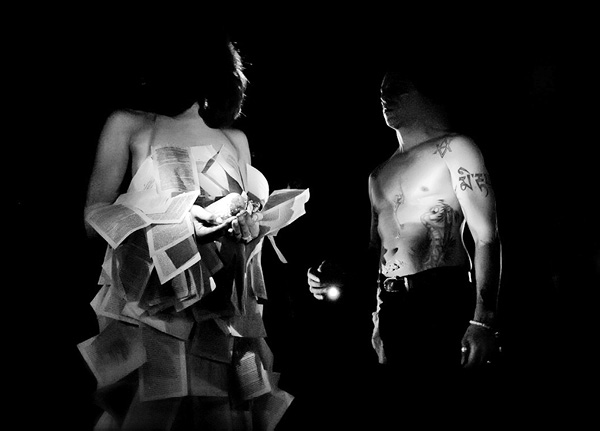
LA PROMENADE DU SCEPTIQUE
first performed on
June 2, 2011
Accademia di Belle Arti, Venice, Italy
performed ten times in 2011
VESTANDPAGE
Verena Stenke, Andrea Pagnes
Florence, Italy
382576025v382576025e382576025r382576025e382576025n382576025a382576025@382576025v382576025e382576025s382576025t382576025-382576025a382576025n382576025d382576025-382576025p382576025a382576025g382576025e382576025.382576025d382576025e
vest-and-page.de
LA PROMENADE DU SCEPTIQUE
VESTANDPAGE
In the performance “La Promenade du Sceptique,” VestAndPage had been inspired by Diderot’s thoughts about the value of humanity: “Man must be the unique point of departure and the point to which all must lead back, if you wish to please, interest and affect people even in the plainest matters and the most barren details.” This had been explored through a shift in sensorial perception and a practical discourse about reciprocal trust.
In this 40 minute performance, both performers are deprived of vision: the male’s eyes are covered by a blindfold, the female’s face is completely covered by her own dense hair. The spectators likewise enter a completely dark space, having been equipped at the entrance with torches for making their way to discover, in the centre of the room, a blanket covered with broken glass pieces, on one side of the room a woman sitting on a chair, dressed in pages of a book, on the opposite side a man holding a book in his hands. The partners whistle sounds to each other through the distance and darkness, slowly shifting the focus from the visual to the auditory. The man takes off his shoes, unbuttons his jacket and shirt to cut his chest longitudinally with a razor; then, bleeding, he enters blindly the field of broken glass. The woman, blind and stiff, falls towards its centre holding a beef heart in her hands. The man catches her falling body. This is repeated one time around the entire field.
The commonplace game of trust (not only between partners) and the idea of the value of the human and its (not only corporal) weight here is brought to an extreme: both protagonists can’t see and their actions, steps and movements are guided through a precarious situation only by their remaining senses. Catching the falling woman, the male risks hurting himself by walking and taking up her falling weight on the broken glass. For Verena Stenke and Andrea Pagnes, making art in a bipolar sphere is to be conscious that what is individual is also reciprocal, that nothing exists on its own, and that the phantasm of an intimate sphere, which contains only one inhabitant (the single itself), is a real-fiction that modern society tries to uphold for ensuring the solitary confinement of each individual in a networked foam. Here, in this bipolar art action, the status of one couple resonates constrained in a performatic space bubble, while, at the same moment, remembrances of it are dispersed and transformed into splinters of ephemeral time.